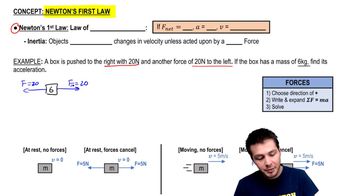Here are the essential concepts you must grasp in order to answer the question correctly.
Newton's Laws of Motion
Newton's Laws of Motion describe the relationship between the motion of an object and the forces acting on it. The first law states that an object at rest stays at rest unless acted upon by a net force. The second law quantifies this relationship with F=ma, indicating that the acceleration of an object is directly proportional to the net force and inversely proportional to its mass. The third law states that for every action, there is an equal and opposite reaction, which is crucial for understanding the forces acting on the skier.
Recommended video:
Centripetal Force
Centripetal force is the net force required to keep an object moving in a circular path and is directed towards the center of the circle. In the context of the skier sliding down the sphere, this force is provided by the gravitational component acting towards the center of the sphere. If friction is present, it alters the net force acting on the skier, potentially affecting the angle at which the skier leaves the surface of the sphere.
Recommended video:
Intro to Centripetal Forces
Energy Conservation
The principle of energy conservation states that energy cannot be created or destroyed, only transformed from one form to another. In this scenario, the skier converts gravitational potential energy at the top of the sphere into kinetic energy as they slide down. If friction is introduced, some energy is dissipated as thermal energy, which can affect the skier's speed and the angle at which they leave the surface, leading to a different trajectory compared to a frictionless scenario.
Recommended video:
Conservation Of Mechanical Energy
 Verified step by step guidance
Verified step by step guidance Verified Solution
Verified Solution



 6:43m
6:43m